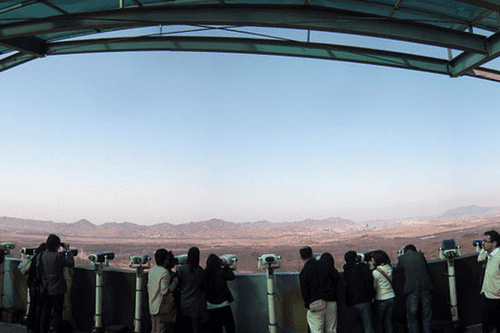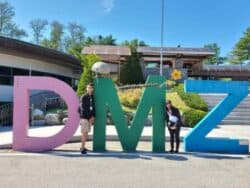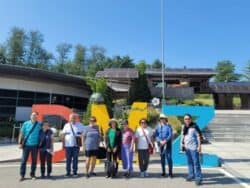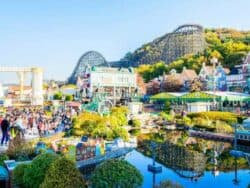Visiting the Korean DMZ (Demilitarized Zone) is one of the most popular day trips from Seoul. It’s a great place to learn about Korean history. You can only visit the DMZ with a guided tour, so make sure to book in advance—preferably at the start of your trip.
Sometimes, the DMZ can close without warning. If the main entry points to the DMZ are closed due to political reasons, it’s good to have a backup plan. There are still other places where you can see views of North Korea. Want to know how to visit there? Keep reading!
In a hurry to find the best DMZ tours?
Read also:
- An introduction to the Korean DMZ
- How to plan a trip to the DMZ?
- A complete guide to visiting the Korean DMZ
- Regional Korean DMZ attractions
- The best DMZ tour to visit Korean DMZ
- FAQs about the DMZ Korea
- Q: Which DMZ tour is the best?
- Q: Is the DMZ in Korea a place where fighting takes place?
- Q: How far is it from Seoul to the DMZ?
- Q: Is it safe enough to go to the DMZ?
- Q: Can you go through the DMZ?
- Q: What's the Joint Security Area?
- Q: Who owns the Korean DMZ?
- Q: Can kids visit the Korea Demilitarized Zone?
An introduction to the Korean DMZ
What is the Korean DMZ (Demilitarized Zone)?

Source: onedaykorea.com
The word “DMZ” stands for “Demilitarized Zone.” The Korean Demilitarized Zone (DMZ) formed in 1953, marking the division between North and South Korea after the Soviet Union and the United States split control of the peninsula following World War II. A buffer zone without weapons now runs along the border between the two countries.
The Demilitarized Zone has a length of around 250 kilometers (160 miles) and a width of roughly 4 kilometers (2.5 miles). The peace deal that stopped the conflict was ratified in 1953. However, since the two sides never signed a peace treaty, they are still technically at war—even after more than sixty years. While no troops stand inside the Demilitarized Zone (DMZ) itself, both North and South Korea have heavily armed forces positioned just outside the 4-kilometer-wide strip, except in the Joint Security Area (JSA).
History of DMZ
In 1953, Korea was split in half because of the Korea war, which was still going on. Even though things are calmer between the two countries now, they are still at war. The division on the peninsula has caused families to be split up, people to die, people to live in poverty, and a terrible dictatorship in North Korea.
The DMZ separates North Korea, which is a communist country, from South Korea, which is a democratic country. It is on the 38th parallel, the original dividing line after World War II. The U.S. controlled one side, and the Soviet Union held the other. The DMZ was made when North and South Korea agreed in 1953 to move their troops back 1.2 miles.
Note: The border between North Korea and South Korea is closed. This means that NO ONE can cross the border between the two Koreas. You can’t go directly from South Korea to DPR Korea or the other way around. You must stop in a third country like China or Russia to get between the two Koreas. The only place you can take a few steps into the other side is the T1-T3 conference rooms, also called “blue houses.” These tent-like one-story buildings sit right on the line between the two sides.
Find & Compare the Best Activities in Korea!
What to do at the Korean DMZ?

Source: bordersofadventure.com
The Bridge of Freedom, Dora Observatory, Dorason Station, and the 3rd Infiltration Tunnel are the main places to see at the DMZ. The Joint Security Area, also called Panmunjom, is another place some tours go to.
The DMZ in South Korea has much to do with people who want to learn about history and politics. On a typical trip to the DMZ, you might see Imjingak Park, which was built as a safe place where North Korean refugees could go to feel better. You’ll pass by the Unification Pond, shaped like the Korean peninsula. This is a lovely place to take pictures. The Peace Bell is right next to the pond.
When you cross the Bridge of Freedom, built in 1953 and used to free 12,773 prisoners, you will be able to walk through history. The Third Infiltration Tunnel is another place you shouldn’t miss. One of the most intriguing parts of the tour is probably going inside the tunnel. It is 1,635 meters long, two meters high, and two meters wide. In 1978, South Korea was the first to find it. The tunnel was built so the North could spy on the enemy camp.
You can get a good view of the Korean Demilitarized Zone (DMZ) from the Dorasan (Dora) Observatory. You can also see straight into the mysterious North on a clear day. For people interested in history, the DMZ Exhibition Hall and DMZ Theater have a lot of exciting facts, documents, and photos from over the years.
Seasonal Picks by IVisitKorea!
How to plan a trip to the DMZ?
You can take a tour from Seoul to the DMZ, and the things you see on the tours are pretty much the same. Some tours will also take you to the JSA if you want to see both. On the other hand, these tours cost more and last all day. Most of the sights along the DMZ can only be seen at a certain time because many areas are heavily armed and behind the Civilian Control Line. Now, here is how to choose the best DMZ plan for you.
Choose the destinations that interest you.
Several companies offer tours of the DMZ. This is a proper way to visit the DMZ on time because civilians aren’t allowed to go there without a military guide. No two tours are the same, but you should choose one based on your budget, customer reviews, and the things you want to see. GetYourGuide and Viator allow you to look through tours with reviews, prices, and instant confirmation. Here are some famous attractions that you can choose from: The area of Joint Security (JSA), Odusan Unification Observatory, Infiltration tunnels, Dora observatory, and Freedom Bridge.
Choosing a tour.
After you decide on your must-see sights, you can select a tour. Best DMZ tours are listed at the end of this article. You pay ahead of time and get confirmation quickly, so you must bring your voucher to the tour. Reviews, pictures, and videos make it easy to choose the suitable tour. When booking directly with traditional companies, you must send and receive emails or call back and forth.
A complete guide to visiting the Korean DMZ
Route to Korean DMZ
The Korean DMZ Peace Train is a tourist train that leaves Seoul and goes to the DMZ. KORAIL runs this train route. There are three routes that the train takes: the Dorasan Security Tour, the Yeoncheon Dreaming Tour, and the Cheorwon Security Tour. Each tour package is a one-day tour that goes both ways.
Many places are past the Civilian Control Line and are not open to tourists because of this. Sign up for a tour package like the DMZ Peace Train, run by KORAIL, to enjoy the DMZ in comfort. Visitors can only go to Panmunjeom with an approved tour agency. More importantly, people who want to go to the DMZ must bring valid identification or a passport. Tourists are also reminded that taking pictures is very limited, so they should check before doing so.
Dorasan Station

Source: trip.com
The Gyeongui Line, which goes from Seoul to Sinuiju, stops at Dorasan Station, one of the northernmost stops on the line. Kim Dae-Jung – the former president of South Korea, and George W. Bush – the former president of the U.S., went to the station. The station has become a sign of the work done to make Korea one country.
Dorasan Peace Park

Source: tripadvisor.com
The pond in Dorasan Peace Park is in the shape of the Korean peninsula, and there is a boardwalk around it. You can learn about Dorasan Station’s history and the DMZ’s ecosystem in the park’s exhibition hall.
Dora Observatory

Source: commons.wikimedia.org
Dora Observatory is the most northerly observatory on the western side of the DMZ. The North Korean city of Gaeseong, the Statue of Kim Il-sung, and Songaksan Mountain can all be seen through binoculars. The area just past the observatory is a military outpost command, so you can’t take pictures here. Also, the observatory is inside the Civilian Control Line, so people who want to go there must join the Dorasan Security Tour.
The Third Tunnel

Source: nytimes.com
The third infiltration tunnel was found in 1978. It was dug by the Northern army to spy on the Southern army. The tunnel is 1,635 meters long and 2 meters tall and wide. It is thought that more than 30,000 soldiers could have used the tunnel in just one hour. It is now a tourist attraction that has everything: a DMZ video hall, sculptures with meaning, gift shops, and more.
Reservations:
– Online: www.letskorail.com
– On-site: You can get a tour package at each station from the KORAIL Travel Center. Foreigners can buy train tickets from Yongsan Station to Dorasan Station online. Still, if they want to go further, they must sign up for the Dorasan Security Tour at Dorasan Station.
Regional Korean DMZ attractions
Attractions in Paju-si, Gyeonggi-do
Imjingak Resort

Source: english.visitkorea.or.kr
Imjingak Resort is a tour complex for unification and security that includes Imjingak, the North Korea Center, Unification Park, and several monuments and memorials. Pyeonghwa Nuri Park has many events, performances, and exhibitions to promote peace and reunification. Hill of Music, a large grassy slope, and Pinwheel Park, where more than 3,000 colorful pinwheels spin freely in the wind, is the park’s most popular places.
In the Imjingak Resort area, you can also visit Imjingak Peace Land, a small amusement park, and the National Memorial Hall of the Korean War Abductees, which teaches people about the people who were taken during the Korean War.
Odusan Unification Tower

Source: english.visitkorea.or.kr
One of the most accessible places to get to from Seoul is the Odusan Unification Observatory. This observatory was on top of the hill with a view of where the Imjingang and Hangang rivers meet. Soldiers used it as a strategic place to watch over and protect both Gaeseong and Seoul. With the help of the binoculars on-site, you can look at the North Korean land on the other side of the river.
Attractions in Yanggu-gun, Gangwon-do
Yanggu Unification Hall

Source: ygtour.kr
The Yanggu Unification Hall has pictures showing what life is like in North Korea. The hall was built to be a place where people could learn how to bring the country together. Visitors can also buy things from North Korea and the mementos of the unification.
Eulji Observatory

Source: flickr.com
About one kilometer south of the Military Demarcation Line (MDL) is the Eulji Observatory. From the observation stand, you can see five peaks of North Korea’s Geumgangsan Mountain, which is known as one of the most beautiful mountains on the Korean peninsula. The observatory is also considered one of the best places to see the misty Punch Bowl basin.
*Note: Temporarily closed
Yanggu War Memorial Hall

Source: ygtour.kr
Some of the fiercest battles of the Korean War happened in Yanggu. The Yanggu War Memorial Museum was built to remember the struggle and the people killed. Over 500 weapons and other items from the war are shown in the exhibition hall. In another part of the museum, testimonies from people who lived through the war show what life was like back then.
The Fourth Tunnel

Source: notesonslowtravel.com
In 1990, the fourth tunnel dug by the North Korean Army to get into the South was found. Visitors can only go into the tunnel up to 100 meters from the DMZ, where there is a blockade to keep them out. At the tunnel’s entrance is a security education center with rusty canteens, helmets, and other items that North Korean soldiers used during the war.
Note: under construction
Attractions in Goseong-gun, Gangwon-do
Unification Observatory in Goseong

Source: korea.hss.de/en/
The northernmost place to look out over Korea is the Goseong Unification Observatory. On the second floor of the Unification Hall, there is an observation deck with binoculars that people can use to see North Korea. On days when the air is clear, tourists may also see North Koreans going about their daily lives. Also, the observatory’s 6.25 Experience Hall has exhibits that let people imagine what it was like to live during the Korean War. These include the War Experience Room, the Planned Exhibition Room, the Photo Exhibition Hall, and more.
DMZ Museum

Source: gangwon.to/en/
The DMZ Museum comprises four themed exhibition halls and several other buildings, such as a theater and a particular exhibition center. The museum tells visitors everything there is to know about the DMZ, from its history to reports on its future ecological and cultural value. 3D documentaries about the Korean War and its aftermath can be seen at the theater. People who want to see the museum at the Goseong Unification Observatory must pay an entrance fee.
To get in, people must stop at the Unification and Security Park and sign up. Pay to get into the Unification Observatory after taking a short course on security. (You can’t just go into the DMZ Museum)
Hwajinpo

Source: english.visitkorea.or.kr
Hwajinpo is a lagoon, a rare type of ecosystem in Korea. Reeds live in this ocean-made lake, and thousands of migrating birds stop by to see them. Pine trees that are 100 years old form a forest around the lake. The Hwajinpo History & Security Museum is in this beautiful area. Here, people can learn more about Korea’s history and security education, which goes back over 50 years.
The entrance fee to the Hwajinpo History and Security Museum includes the Villa of Kim Il-sung, the Villa of Syngman Rhee, the Villa of Lee Ki-poong, and the Marine Eco Museum.
Panmunjeom Tour

Source: klook.com
The only place in the world where North and South Korean leaders meet is at Panmunjeom and the Joint Security Area around it. It has stood for over 50 years as a representation of the Korean War and the hard work needed to bring the two countries back together. Since Panmunjeom is the closest place to North Korea, many people from other countries want to go there. Tour agencies offer many different kinds of tours to interested people.
Things to remember when booking the DMZ Tour
Advance booking is ideal
Our number one DMZ tour rule is to book your visit ahead of time. Ideally, as soon as you settle on your dates to visit Seoul. To begin with, this can be because DMZ tours book up quickly and spots are limited.

Another reason is that for security reasons, you must book it at least 3 days in advance in order to get a security clearance. DMZ visits from Seoul run Tuesday through Friday, with the exception of special political occasions and amid military events. There’s no way of knowing ahead of time when these off cancellations will happen. Visits can even be canceled the day of. It’s imperative to keep in mind that the DMZ zone is still a functioning military zone, and military exercises trump the tour.
Plan which DMZ tour you want to explore

- A DMZ tour stops at the Dora Observatory, Dorasan Street, and visits a tunnel that was dug to transport spies into South Korea. All fascinating stuff. But, It does not stop at the JSA, the Joint Security Area.
- The JSA Tour makes a stop at the Mt. Odu Unification Observatory. You can see a clear view of North Korea as it takes you into the blue conference room that reaches across the MDL, or the Military Demarcation Line, which straddles both North and South Korea.
Your passport should be with you at all times
You have to provide your passport at least two days before your scheduled DMZ Tour. As it is a military border your passport will be checked and you are expected to show it every time it is asked you by your guide.

Pack light and dress conservatively
There is a strict dress code policy in which ripped jeans, commercial, and camouflage clothing is not allowed on the DMZ tour. Also, the North Koreans watching can take pictures and be pretty judgmental of the clothes people wear. Also, you have to leave your bags behind on the bus in many places due to security concerns, so don’t bring stuff that you might not be able to leave behind when requested to.
Waiver
On the JSA section of the tour, due to the volatile nature of the border, you will be asked to sign a waiver that states that no one is not responsible for accidents, injury, or even death. It sounds scary but the fact is that tons of tourists are visiting the JSA daily under military escorts.
Shopping & Souvenirs at the Korean DMZ
The gift shop at American Camp Bonifas, which is located close to Panmunjeom, sells a variety of unique mementos, such as t-shirts and mugs, that will serve as a reminder of the time you spent getting close to North Korea or even of the time, you walked into North Korea itself in the quiet village.
The best DMZ tour to visit Korean DMZ
Many companies offer tours of the DMZ, and most of what you see on the terms is the same. So, what does an average DMZ tour from Seoul include?
Best DMZ Half-day Tour
On a stress-free half-day tour from Seoul, you can see the best parts of the DMZ. Your group will go to Imjingak Pyeonghwa-Nuri Park and the Bridge of Freedom. Next, tour the DMZ, the Third Tunnel, and the Dora Observatory. From the beginning to the end, your guide will give detailed commentary to ensure you make the most out of your visit and learn a lot. You’ll have plenty of time to do whatever you want in the evening when you return to Seoul. Visit the DMZ and all of the places of interest near it. Travel in comfort on transportation that goes both ways. All museums will let you in for free.






Best DMZ Full-day tour
Take a full-day tour from Seoul that takes you to the DMZ (Demilitarized Zone) in the morning and back to Seoul in the late afternoon. Imjingak Park, the 3rd Infiltration Tunnel, the DMZ Exhibition Hall, the Dora Observatory, the Dorasan Station, and the Unification Village are some of the best sites of the DMZ. Return to Seoul for lunch, then go to the War Memorial of Korea before your tour ends in the late afternoon.
Full-day trip from Seoul to the DMZ and the War Memorial of Korea. With a guide, you can see the best of the DMZ. From Dora Observatory, you can use telescopes to look at North Korea. Learn about the entire history of the Korean War and what it left behind. Spend time at the Korean War Memorial. Includes lunch, transportation, entrance fees, and hotel pickup. Lunch and a trip to the War Memorial of Korea are included if you choose the full-day tour.



![[DMZ Private Full day Tour] & The War Memorial include Lunch](https://ak-d.tripcdn.com/images/35091g000001h66l17A9E_C_568_320_Q80.jpg)

Best DMZ private tour
On this 8-hour Demilitarized Zone tour from Seoul, you can learn more about the history and culture of the Korean Peninsula. With a guide, you can see the DMZ, where North and South Korea fight the most. Visit exciting places like the Imjingak Pavilion, the third infiltration tunnel, and the Unification Bridge, which was used to exchange prisoners in 1953. From the Dora Observatory, you can see the North Korean propaganda village.
After lunch, you’ll go to the N Seoul Tower, the last stop on your private tour. 8-hour tour of the DMZ with a guide from Seoul Visit essential places like the third infiltration tunnel and the Unification Bridge. From the Dora Observatory, you can look out over the propaganda village in North Korea. The N Seoul Tower Tour picks you up and drops you off at your hotel in Seoul.
This is a private tour when a tour guide and a private vehicle are provided.





FAQs about the DMZ Korea
Q: Which DMZ tour is the best?
A: The best way to decide between your choices is to know what makes each unique. A half-day DMZ tour goes to all the most critical places, like Imjingak Park, The Bridge of Freedom, The DMZ Theater & Exhibition Hall, The 3rd Infiltration Tunnel, Dora Observatory, and Dorasan Station. During a full-day DMZ tour, the Joint Security Area (JSA) is also visited in the afternoon.
It’s important to remember that there are more rules for getting into the JSA. Children must be at least 12 years old, there is a limitation to how many people can visit each day (set by UN Command), and reservations must be made at least 72 hours prior.
So, if you want to visit with younger children, have a busy schedule, or need to book quickly, you should choose the half-day option. You should select the full-day option if you want to stay longer and go into the JSA in the afternoon.
Q: Is the DMZ in Korea a place where fighting takes place?
A: Even though South Korea’s DMZ is as close as you can get to a war zone, there is usually no fighting. In other words, you probably won’t see any shootings or other violent acts. The main goal of the Korean Demilitarized Zone is to promote peace and show that safety can be reached without actively using force. There are some very unique things about the zone.
Q: How far is it from Seoul to the DMZ?
A: A sign at Imjingak says that it is 53 km to Seoul and only 22 km to Kaesong. The Demilitarized Zone (DMZ) in South Korea is about 50 kilometers from Seoul (38 kilometers from Pyongyang). The trip takes between 60 and 90 minutes, depending on where you start in the city and how busy the roads are that day. You must go through several security checkpoints the military runs to get there. Your tour guide will ask for your passport, and you’ll have to show it to a soldier so he or she can check it.
Q: Is it safe enough to go to the DMZ?
A: Even though the DMZ in Korea is called “the world’s most dangerous border,” neither civilians nor tourists are in danger. Even though the DMZ is still a war zone, it has become a place where peace can last, so it is safe to go there. The only thing that might still seem dangerous is that many North, South, and U.S. troops protect the territory and can be seen patrolling the area. Nothing to worry about if you want to tour the Demilitarized Zone (DMZ). Guided tours are allowed and help the country’s tourism industry.
Q: Can you go through the DMZ?
A: In short, you cannot cross the Demilitarized Zone in Korea. This goes for both soldiers and tourists. Even though North and South Korea share this border, their immigration and travel policies differ. The North is also known for making it hard to travel, so if you want to go deeper into North Korea, you’ll need to get a visa and fill out more paperwork.
But you can cross the Military Demarcation Line, the border between the two countries. The line is inside the building that houses the United Nations Command Military Armistice Commission (UNCMAC). In this case, you will technically be in North Korean territory.
Q: What’s the Joint Security Area?
A: The Demilitarized Zone includes the Joint Security Area (JSA). This is one of Korea’s most exciting places to visit inside the DMZ. It is also called Panmunjom or the Truce Village. Here, soldiers from different sides face each other. The JSA’s job is to be a neutral place where the two countries can talk, with help from the UN Command Military Armistice Commission (UNCMAC).
A lot of rules apply to the JSA. Remember to make reservations 72 hours in advance, pay attention to the dress code, and ensure that your group’s youngest person is at least 12 years old.
Q: Who owns the Korean DMZ?
A: The DMZ area in Korea is neutral territory, meaning neither side owns it. Suppose you’re wondering who runs the DMZ. In that case, the MDL (Military Demarcation Line) shows that the United States helps patrol the area, along with troops from both Koreas. Both battalions have rules that tell them where they can and cannot go while patrolling. At each end of the DMZ, there are two kilometers with no soldiers. No one from either side can cross the MDL. If you do this, it will be seen as an act of aggression and could lead to a fight.
Q: Can kids visit the Korea Demilitarized Zone?
A: In general, yes. In most places where tourists can go in the DMZ, it is safe for children to be with a parent or guardian. But some sites that are more politically sensitive or dangerous and therefore not suitable for young children have age limits. So, it’s essential to check your tour’s details to see if there are any age limits or to contact your tour company ahead of time. Since the UN Command makes these rules, they cannot be changed.
The Korean DMZ tour is a worthwhile trip to learn about a global humanitarian crisis. There is no single centralized location that constitutes the Korean DMZ. Somehow, many visitors don’t seem to grasp that concept. You can visit more areas than you think. In addition, a wealth of activities can be enjoyed independently within a reasonable distance of the civilian control zone. So if you want to feel the history of the safest yet most volatile border in the world, then book your tickets to the Korean DMZ Tour as soon as possible.
IVK’s Top Picks – Day Tours, Tickets, and Travel Activities
Seasonal Picks!😍






























Wow. Such detailed description and direction. This makes the visit very easy
Our hotel collecting our passports night prior the morning trip to DMZ. Is that the common?
As for a trip to the DMZ (Demilitarized Zone), it’s normal to have your passport checked as it’s an area with strict security procedures. Tour organizers often collect participant passport numbers and nationalities in advance to submit to the authorities, but they don’t usually physically hold onto your passport.